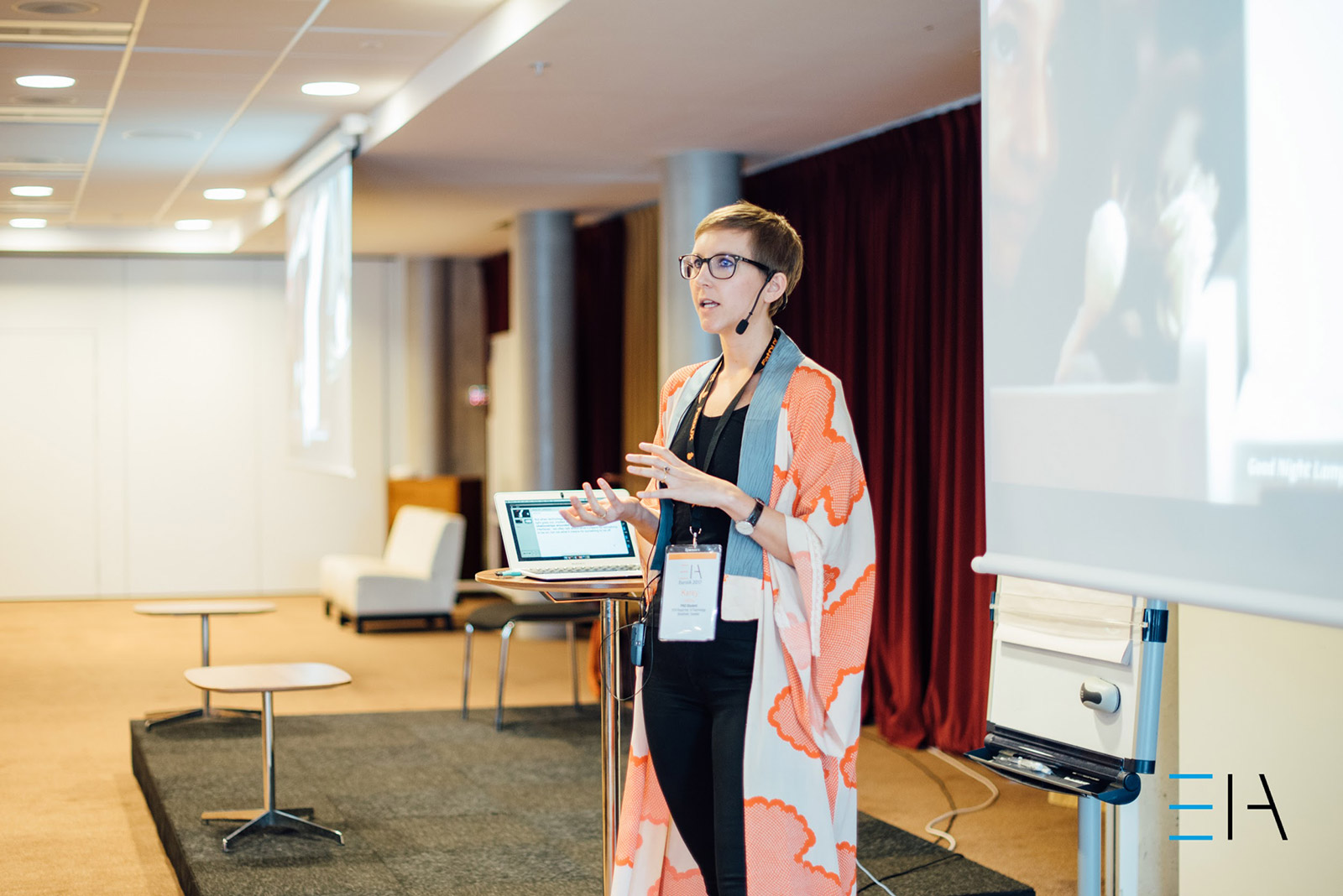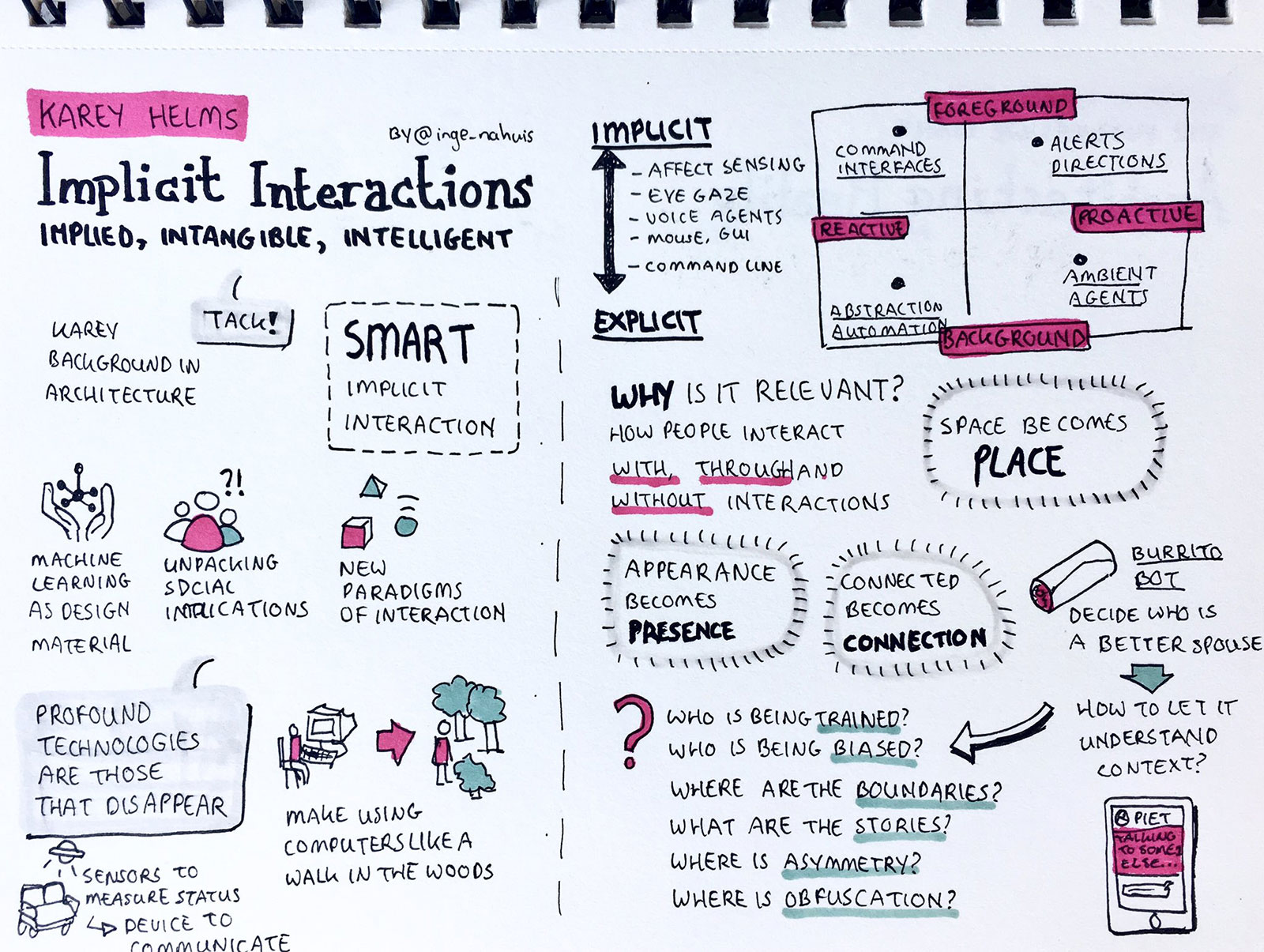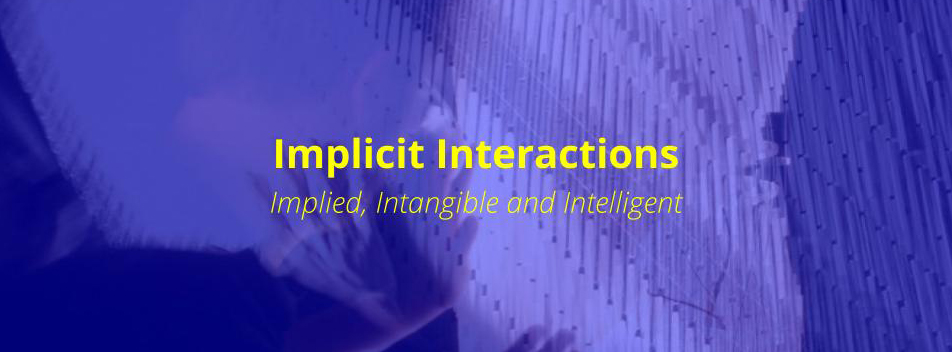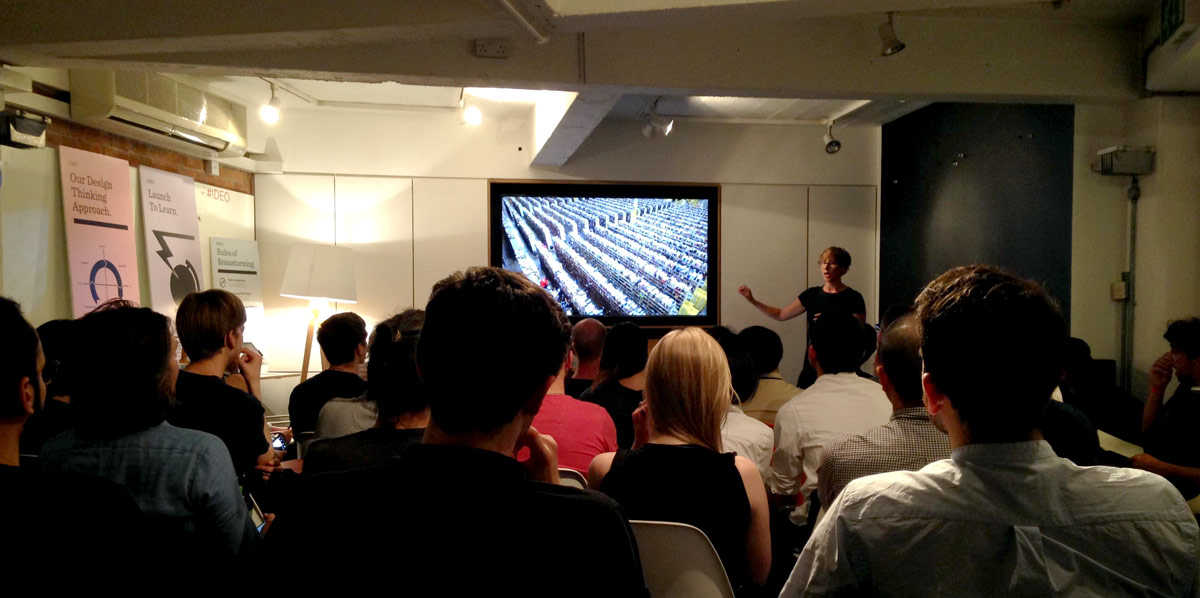Category: Talk
EuroIA 2017 – Smart Implicit Interactions
Two weeks ago I had a lovely time speaking about my current research interests and questions surrounding Smart Implicit Interactions with industry practitioners at EuroIA 2017 in Stockholm!

Thanks EuroIA for the INTENSE photo above and Inge Nahuis for the sketchnotes below!

EuroIA 2017 – Upcoming talk on Implicit Interactions
Very excited to be giving a 20 minute talk on September 30th at EuroIA in Stockholm on Implicit Interactions: Implied, Intangible and Intelligent! Below is my talk abstract.

As our physical and digital environments are ubiquitously embedded with intelligence, our interactions with technology are becoming increasingly dynamic, contextual and intangible. This transformation more importantly signifies a shift from explicit to implicit interactions. Explicit interactions contain information that demands our attention for direct engagement or manipulation. For example, a physical door with a ‘push’ sign clearly describes the required action for a person to enter a space. In contrast, implicit interactions rely on peripheral information to seamlessly behave in the background. For example, a physical door with motion sensors that automatically opens as a person approaches, predicting intent and appropriately responding without explicit contact or communication.
As ambient agents, intelligent assistants and proactive bots drive this shift from explicit to implicit interactions in our information spaces, what are the implications for everyday user experiences? And how do we architect dynamic, personal information in shared, phygital environments?
This talk aims to answer the above questions by first introducing an overview of explicit and implicit interactions in our mundane physical and digital environments. Then we will examine case studies in which unintended and unwanted consequences occur, revealing complex design challenges. Finally, we will conclude with example projects that explore a choreography between explicit and implicit interactions, and the resulting insights into architecting implied, intangible and intelligent information.
IxDA London – Implicit Interactions
Last night I guest hosted and organized an IxDA London event on Implicit Interactions at IDEO. Below is the event description.

As the Internet of Things infiltrates the mundane moments of our daily lives, ubiquitously embedding intelligence into objects and environments – our relationships with technology become increasingly dynamic, contextual, and intangible. Therefore as interaction designers, how do we design what could and should be the resulting invisible dialogues between people, places, and things?
This month we will shift our attention away from classic, explicit interaction paradigms – those that demand our attention for direct engagement and manipulation – to implicit interactions that seamlessly behave in the background. Join us for product, prototyping, and research perspectives as we hear from Hongbin Zhuang, CEO and Co-founder of Olly robot; Karey Helms, a Senior Interaction Designer at Zebra Technologies; and Alex Taylor from Microsoft Research.
MeetUp – Artificial Intelligence, Machine Learning & Bots
Back in June I attended Practical Introduction into Artificial Intelligence by ASI Data Science as part of London Technology Week. The event was very well structured, and more importantly, perfectly distilled complex theories and processes into a digestible format for a novice like myself. I left feeling like an expert, and was able to confidently re-articulate the evening to others, which I think is very much a sign of a well run event and of course, great instructors. Moreover, as I’m navigating the world of artificial intelligence and machine learning in relation to my role and interests as an Interaction Designer, I’m being intentionally thoughtful regarding the Pareto Principle – I don’t actually need to be an expert, but do want a solid 20% foundational knowledge base.
Anyhow, the evening began with a history of artificial intelligence and the corresponding theories of influential scientists on the topic before launching into a hands-on session in which participants built our own handwriting recognition engine. Key takeaways included a clearer understanding of the relationship between artificial intelligence verse machine learning, a new comprehension of artificial neural networks (see slide below), and insights into what is and is not currently possible relative to real world applications.

Fast forward to this past Tuesday, when I attended a MeetUp by Udacity at Google Campus London on Machine Learning and Bots by Lilian Kasem. Very different content and structure but equally insightful. Lilian’s talk was centered around Bots specifically – from the definition of a bot, to a live coding demo of the creation of a bot in Microsoft Bot Framework, and best bot practices – all while weaving in the integration of machine learning if it adds value (I also appreciate her stress on the if). Her resources in the image below:

In addition to the obvious relevance of these two events to current interaction design trends, they are helping me formulate next steps for two of my current projects, one personal and one professional.
The personal project – Burrito, a marriage bot that analyzes messages between my husband and me to determine who is a better spouse – is currently being refactored into a formal bot for Telegram. Lilian’s talk in particular was very helpful as my project focus as transitioned from theoretical to technical as I am now seeking to create a higher fidelity product and implement better, if not best, programming practices.
The professional project, for which I will intentionally be quite vague, investigates the impact of implicit data on enterprise organizational and technical systems, and in particular, the transition from frictionless to exception based workflows. As an Interaction Designer, I firmly believe it is important to not only empathize with humans, but also technology and its corresponding data because the concept of user – who, what, or where – is increasingly being blurred. Therefore, ASI’s introduction into AI was particular helpful in how I understand, design for, and implement data into my professional practice.
Long story short – two great events! In the coming weeks, I am to write a followup post regarding my technical developments in regards to Burrito bot, but also an online course I began this week to formalize my programming skills relative the Internet of Things.
WIAD16 Bristol – Making the Invisible Physical
Below is the loose script and slides from a 20 minute talk I gave in Bristol for World IA Day 2016 – “Information Everywhere, Architects Everywhere.” I presented personal design projects in which I prototype physical manifestations of invisible interactions from the mundane moments of my daily life, and the resulting insights that inform how I make sense of complex sociotechnical systems and dynamic information exchanges to design meaningful enterprise solutions. More information on the event and other speakers in Brisol can be viewed on the Lanyrd event page.
Sustainable Futures at Inside/Out Festival
Not really having any idea what I was signing up for, on Tuesday I attended the Sustainable Futures breakfast salon at the Somerset House by Editorial Intelligence as part of the Inside/Out Festival. The morning included three brief introductions by a guest panel comprised of Jim Haywood, Sandy Black and Olivia Knight followed by casual questions and discussion.

As my recent thesis incorporated similar themes regarding sustainability, consumerism and the individual vs the collective’s relationship with energy – I’m quite critical on the topic. That being said, I found Haywood’s and Black’s perspectives rather trite. While obviously an extremely knowledgable sustainability consultant, Haywood presented a wealth of environmental statistics and projections that I believe alienate the individual from personal action due to the unintentional cross-over into environmental scare tactics. I’m personally against scare tactics for their growing overuse and potential desensitization to the topic, as well as their portrayal of this ‘larger than life’ problem in which it becomes too easy for an individual to view it as a global issue in which that can’t have an impact. Don’t get me wrong, climate change IS a very large global issue, I’m just being critical on how we inspire and instigate behaviour change and collective action. On the other hand, Haywood’s concluding analogy was strong and on point – wish he would’ve played it through his entire talk. He compared sustainability to climbing Mount Everest:
- Take the first step up the mountain, beginning with individual action
- Rope in the other climbers, to summit the mountain is a join initiative
- Scale the mountain, but be sure to enjoy the view and see that its worth it.
Professor Sandy Blank spoke from a fashion perspective, bringing a specific vantage point rooted in the dichotomy between fashion as an embedded cultural construct and its complex lifecycle problems. She highlighted the competing paradigms of aspirational (think Oscar gowns) verses FastCheapNow (think Primark), and how a growing shift toward the latter is resulting in shocking amounts of textiles waste. I could be wrong, but I don’t remember her mentioning all the other environmentally unfriendly practices embedded within the entire fashion supply chain (disclaimer: strict time restrictions on the talks), and felt she shifted a bit too strongly towards defending the positives of fashion – enabling self-confidence, social communication, etc. While these are valuable points, and myself as a fashion advocate believe in, I was left waiting for a disruptive solution. Maybe its me, missing the purpose of these talks, because they definitely lead to valuable discussions, but perhaps I keep naively awaiting an effortless answer…
…which was given by the third speaker, Olivia Knight. And it made my day. Knight is the founder of Patchwork Present, a website where friends and family can contribute to the one gift you really want, rather than buying you 25 you don’t want. She is the first to mention that collaborative gift giving isn’t a new idea, she just made it digital and easy. While I find Knight’s business innovative for disrupting an timeless tradition (gift-giving) by both modernizing and making universally accessible an existing solution (collaborative consumption), hearing her clearly articulated thoughts on consumption made me want to run up and give her a double high-five. She began with the tension between want and waste, highlighting our human nature to need or covet things. And we do need stuff, but “we don’t want to feel bad wanting.” Unfortunately though, we often consume what we don’t need and show our love for another by buying even more things we don’t need. Patchwork Present addresses the latter by facilitating collaborative consumption of the things, or thing, you really do want. Through this smarter consumerism, want is in turn celebrated, while I believe also taking an actionable step forward towards a more sustainable future.
Needless to say, I was impressed with Knight, and though perhaps critical on the morning as a whole, overall enjoyed the diverse perspectives and discussions.